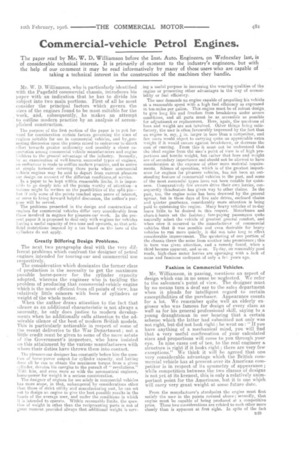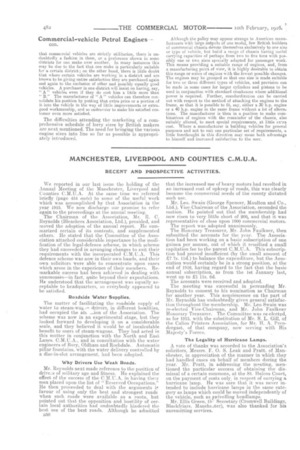Commercial-vehicle Petrol Engines.
Page 15

Page 16

If you've noticed an error in this article please click here to report it so we can fix it.
The paper read by Mr. W. D. Williamson before the Inst. Auto. Engineers, on Wednesday last, is of considerable technical interest. It is primarily of moment to the industry's engineers, but with the help of our comment it may be read informatively by many of those users who are capable of taking a technical interest in the construction of the machines they handle.
Mr. W. D. Williamson, who is particularly identified with the Pagefield 'commercial chassis, introduces his paper with an .indication that he has to divide his subject•into two main portions. First of all he must consider the principal. factors whichgovern the sizes of the engines foundlo be most .suitable for the work, and, subsequently; he Makes an attempt • to Outline .modern practice by an analysis Cf ac.e-orn
• plished construction. . .
The purpose of tho first portion of the paper is to put forward for consideration certain 'factors governing the Sizes of engines suitable for use in commercial vehicles, and by,prolnoting discussion upon the points raised to endeavour to direct iffort towards greater uniformity and •possibly a closer co, operation among commercial vehicle manufacturers and engine hullers to the general advantage of the industry. Secondly, ky an examination of well-known successful types of engines, aii endeavour is made to outline modern practice, and to arrive it. simple formulae covering those parts where commercial vehicle engines may be said to depart from, current pleasure car design, on account of the different conditions,of service. Ii a paper to he kept within reasonable limits, it is impossible to go deeply into all the pioints worthy of attention—a volume might be written. On the possibilities of the split pin— lint if only some of the points touched upon prove of interest, or serve to bring forward helpful discussion, the author's purpose will be served.
The problems presented in the design and construction of engines for commercial vehicles differ very considerably from those involved in engines for pleasure-car work. In the present. paper it is proposed to deal only with engines for vehicles having a useful capacity of two tons and upwards, so that arti-• licial restrictions imposed by a tax based on the bore of the L2,•linders do not apply.
.Greatly Differing Design Problems.
The next two paragraphs deal with the very different problems which confront the designer of petrol engines intended for touring-car and commercial use respectively.
The consideration which dominates the former class of production is the necessity to get the maximum possible horse-power for the cylinder capacity adopted, whereas the engineer who is tackling the problem of producing that commercial-vehicle engine which is the most efficient from all points of view, has -relatively little concern with bore of cylinders or weight of the whole motor.
When the author draws attention to the fact that silence as an additional characteristic is not always a necessity, he only does justice to modern developments when he additionally calls attention to the admirable -silence of the best of modern British models. This is particularly noticeable in respect of some of the recent deliveries to the War Department ; not a little credit must be given to some of the. more astute of the Government's inspectors, who have insisted on this attainment by the various manufacturers with -whom their duties have thrown them into contact.
The pleasure-car designer has constantly before him the quest ion of horse-power output for cylinder capacity, and having dorm all he can to obtain the maximum torque from a given ovilinder, devotes his energies to the pursuit of " revolutions." ',Vitt' him, and even more so with the aeronautical engineer, horse-power for weight is a serious consideration.
The designer of engines for use solely in commercial vehicles has more scope, in that, unhampered by considerations other than those of strict utility and manufacturing cost, he can set out to design an engine to give the best possible results in the hands of the average riser, and under the conditions in which it is intended to operate. Within reasonable limits, the question of weight in other than the reciprocating parts is not of great moment provided always that additional weight is serv ing a useful purpose in increasing the wearing qualities of tho engine or presenting other advantages in the way of accessibility or fuel efficiency..
The user demands an.engine capable of propelling his vehicle at a reasonable speed with. a high fuel efficiency as .expressed in ton-miles per gallon. This.engine must he of robust design, to give long life and freedom from breakdown under severe conditions, and all parts must be. accessible as possible • , for adjustment or replacement. Here, again, the questions of
bore and weight km not involved. Other things 'being. satisfactory, the user is often favourably impressed by the fact that an engine is, say,, -1 in. larger-in bore than a competitor, and few users would object to carrying quite an appreciable extra weight if it would ensure against breakdown, or decrease the cost of running. • From this it must not be understood that the ideal engine from the niser's point of view is of high proportions and terrific weight, but rather .that bore and weight are of secondary importance and should not be allowed to have consideration at the expense of other more material requirements. Silence of operation, which is of the greatest importance for engines for pleasure vehicles, has not been an outstanding feature of commercial vehicles in the past, and some of the most successful types have not been notable for quietness. • Comparatively few owners drive their own lorries, consequently this4feature has given way to other claims. In the
• past, too, the engine noise has been drowned by the general uproar, but in these days of live axle drives, enclosed chains and quieter gearboxes, considerably more attention is being paid to quietening the engine. Many heavy vehicles of to-day leave little to be desired in this respect. Motorbuses and chars-ilibadics set the fashion ; fare-paying passengers quite naturally select the vehicle of greatest general comfort, and when once it occurred to the manufacturer of commercial vehicles that it was possiblo and even desirable for heavy vehicles to run more quietly, it did not take long to effect considerable improvement. The quietening of one portion of the chassis threw the noise from another into prominence; this in turn was given attention, and a remedy found, when a third became apparent, and so on, To-day, on reasonably good roads, high-class motor lorries are operating with a lack of noise and fussiness undreamt of only a fev• years ago.
Fashion in Commercial Vehicles.
Mr. Williamson, in passing, mentions an aspect of design which can in no sense be 'neglected. We refer to the salesmen's point of view. The designer must by no means turn a deaf ear to the sales department when it pleads for intelligent regard to certain susceptibilities of the purchaser. Appearance counts for a lot. We remember quite well an elderly engineer who was famous for design of every class as well as for his general professional skill, saying to a young draughtsman in our hearing that a certain .scheme which the latter had submitted not only was not right, but-did not look right; he went on : "It you have anything of a, mechanical mind, you will find that a, very useful confirmation of your 'calculated sizes and proportions will come to you through your eye. In nine cases out of ten, to the real engineer, a structure is right if it looks right ; there are very few exceptions." We think it will be agreed that one very considerable advantage which the British commercial vehicle has at present over its American competitor is in respect. of its symmetry of appearance ; while competition between the two classes of designs is not yet at its keenest, this is only a relatively unimporta.nt point for the Americans, but it is one which will carry very great weight at some future date.
From the manufacturer's standpoint the engine must first satisfy the user in the points covered above; secondly, that engine must be capable of being produced at a competitive price. These two considerations are related to each other more closely than is apparent at first sight. In spite of the fact that commercial vehicles are strictly utilitarian, there is undoubtedly a fashion in them, or a preference shown in some districts for one make over another. In many instances this may be due to the fact that one make is particularly suitable for a certain district ; on the other hand, there is little doubt that where certain vehicles are working in a district and are known to be giving entire satisfaction they are purchased again and again to the exclusion of other and possibly equally good vehicles. A purchaser in one district will insist on having, say, " A " vehicles even if they do cost him a little more than " B." The manufacturer of " A " vehicles can therefore consolidate his position by putting that extra price or a portion of it into the vehicle in the way of little improvements or extragood workmanship, and so endeavour to make his satisfied customer even more satisfied.
The difficulties attending the marketing of a comprehensive schedule of lorry sizes by British makers are next mentioned. The need for bringing the various engine sizes into line so far as possible is appropriately introduced.
Although the policy may appear strange to American manufacturers with large outputs of one model, few British builders of commercial chassis devote themselves exclusively to one size or type of vehicle, hut build a range of chassis having useful carrying capacities of perhaps from two to five tons with possibly one or two sizes specially adapted for passenger work. This means providing a suitable range of engines, and, from a manufacturing point of view, it is highly desirable to obtain this range or series of engines with the fewest possible changes. The engines may be grouped so that one size is made suitable for two or three different types of vehicles, and provision can be made in seine cases for larger cylinders and pistons to be used in conjunction with standard crankcas.es where additional power is required. Further, standardization can be carried out with respect to the method of attaching the engines to the frame, so that it is possible to fit, say, either a 30 h.p. engine or a 40 hp. engine in the same frame without a lot of altera.. thins. The manufacturer is then in a position to make combinations of engines with the remainder of the chassis, also suitably altered, to meet special requirements, at little extra cost. Where a manufacturer is building vehicles for general purposes and not to suit one particular set of requirements, a little forethought in this direction may mean both advantage to himself and increased satisfaction to the user.




















